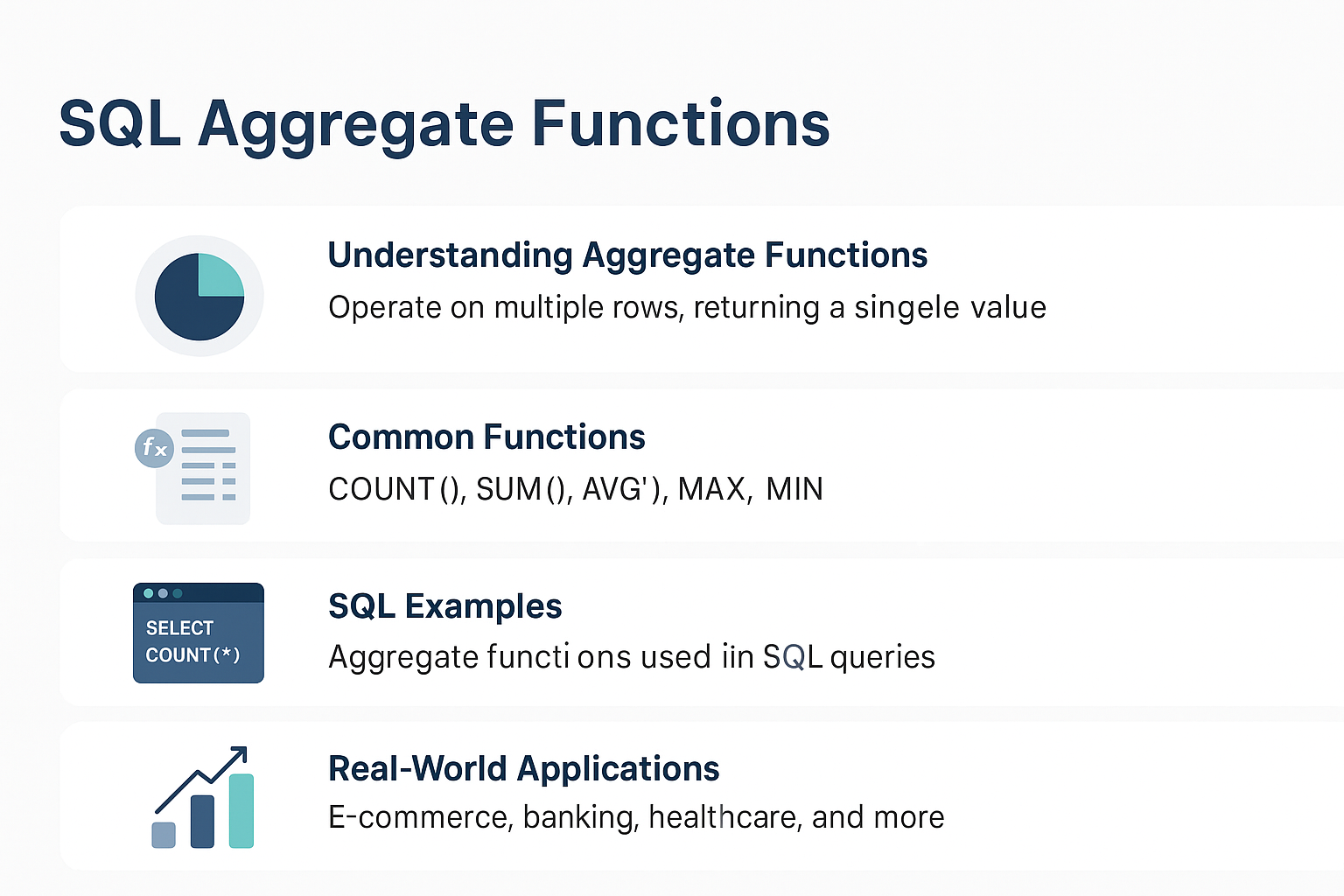Introduction
SQL aggregate functions allow you to perform calculations on a set of values and return a single value. They are essential for reporting, analytics, and summarizing large datasets.
Why It Matters
- Helps in generating reports and insights.
- Summarizes large amounts of data efficiently.
- Essential for business intelligence and analytics applications.
Real-world analogy:
Think of aggregate functions as tools for summarizing a spreadsheet. Instead of reading every sales record, you quickly calculate the total sales, average order value, or highest transaction.
Core Concepts
What Are Aggregate Functions?
Aggregate functions operate on multiple rows and return a single summarized value. They are often used with the GROUP BY clause for grouping results.
Common SQL Aggregate Functions
- COUNT() – Counts rows.
- SUM() – Adds numeric values.
- AVG() – Calculates average.
- MAX() – Finds maximum value.
- MIN() – Finds minimum value.
SQL Examples
COUNT()
SELECT COUNT(*) AS total_customers
FROM customers;
SUM()
SELECT SUM(amount) AS total_revenue
FROM orders;
AVG()
SELECT AVG(amount) AS avg_order_value
FROM orders;
MAX() and MIN()
SELECT MAX(amount) AS highest_order, MIN(amount) AS lowest_order
FROM orders;
GROUP BY with Aggregates
SELECT customer_id, SUM(amount) AS total_spent
FROM orders
GROUP BY customer_id;
Real-World Use Cases
- E-commerce: Calculate total revenue per customer.
- Banking: Find highest transaction per account.
- Healthcare: Compute average patient visit duration.
Common Mistakes and Anti-Patterns
- Using aggregates without GROUP BY: Returns unexpected results.
- Mixing aggregated and non-aggregated columns: Causes errors.
- Using COUNT(*) on large tables without indexes: Leads to slow queries.
Performance and Scalability Implications
- Indexing columns used in aggregates improves performance.
- Large datasets may require materialized views or summary tables.
- Consider approximate aggregate functions for big data (e.g., HyperLogLog).
RDBMS Comparison
| Feature | PostgreSQL | MySQL | Oracle |
|---|---|---|---|
| COUNT() | Fully supported | Fully supported | Fully supported |
| GROUP BY | Advanced features | Fully supported | Fully supported |
| Window Functions | Fully supported | Supported in 8.0+ | Fully supported |
Best Practices & Optimization Tips
- Use specific columns in COUNT instead of COUNT(*).
- Pre-aggregate data in summary tables for heavy reports.
- Use HAVING to filter aggregated results after GROUP BY.
- Combine with window functions for advanced analytics.
When to Use vs When to Avoid
Use Aggregate Functions When:
- Summarizing large datasets.
- Building reports and dashboards.
Avoid Excessive Aggregation When:
- Querying OLTP systems with high transactional load; use a separate analytics DB.
Conclusion & Key Takeaways
SQL aggregate functions are vital for summarizing and analyzing data. Mastering them is key for reporting, analytics, and data-driven decision making.
Key Points:
- Aggregates return a single summarized value.
- Use with GROUP BY for grouped summaries.
- Optimize performance with indexes and summary tables.
FAQ
1. What is an aggregate function in SQL?
A function that operates on multiple rows and returns a single value.
2. Can I use aggregate functions without GROUP BY?
Yes, for summarizing the entire table.
3. What is the difference between COUNT(*) and COUNT(column)?
COUNT(*) counts all rows; COUNT(column) ignores NULL values.
4. Can I combine aggregate functions in one query?
Yes, you can use SUM, AVG, MAX, etc., together.
5. What is HAVING used for?
To filter results after aggregation.
6. Do aggregate functions work with joins?
Yes, commonly used for aggregated reports across tables.
7. Are window functions the same as aggregate functions?
No, window functions perform calculations per row over a set of rows.
8. How to speed up COUNT() on large tables?
Use indexed columns or approximate counting methods.
9. Can I use aggregate functions in subqueries?
Yes, often used to compute summaries for filtering.
10. Are aggregate functions standard across RDBMS?
Yes, core functions are supported across PostgreSQL, MySQL, and Oracle.
